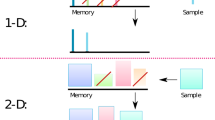Abstract
A mathematical model of a memory trace and forgetfulness is proposed here based on an improved version of our previous work (Harth et al., 1970; Anninos et al., 1970). Thus it was shown that the trace of a stimulus pattern presented to a subject decays with time due to the interference theory which assumes that competition among different associations leads to losses of retention. Such interference theory has been tested in this model by assuming that the retention of a first learned item followed by the learning of other successive tasks, depends on the inhibitory effect induced by them on the first item.
Similar content being viewed by others
References
Anninos, P. A.: Doctoral dissertation. Syracuse University, Syracuse, New York (1969). Publisher Univ. Microfilms, Ann Arbor, Michigan (1970).
Anninos, P. A., Beek, B., Csermely, T. J., Harth, E. M., Pertile, G.: J. theor. Biol. 26, 121–148 (1970).
Bower, G. H.: A multicomponent theory of the memory trace. In: The psychology of learning and motivation, vol. I (K. W. Spence and J. T. Spence, eds.). New York: Academic Press 1967.
Duncan, C. P.: J. comp. physiol. Psychol. 42, 32 (1949).
Harth, E. M., Csermely, T. J., Beek, B., Lindsay, R. D.: J. theor. Biol. 26, 93–121 (1970).
Katchalsky, A., Oplatka, A.: Neurosciences Research Symposium Summaries, vol. 1 (F. O. Schmitt and T. Melnechuk, eds.). Cambridge, Mass.: MIT Press 1969.
Norman, D. A.: J. exp. Psychol. 72, 369–381 (1966).
Norman, D. A.: Memory and decisions. Proceedings of Symposium on Memory and Attention. XVIII. Internat. Congr. of Psychology, Moscow (1966).
Spinelli, D. N.: Computer model for a content addressable memory in the central nervous system. In: Biology of memory (K. Pribram and D. Broadbent, eds.), p. 293–306. New York: Academic Press 1970.
Waugh, N. C., Norman, D. A.: Psychol. Review 72, 89–104 (1965).
Waugh, N. C.: Primary and secondary memory in short-term retention. In: Biology of memory (K. Pribram and D. Broadbent, eds.), p. 63–66. New York: Academie Press 1970.
Author information
Authors and Affiliations
Additional information
This research has been supported by NIH grants NS-8012 and NS-8498, and NSP grant GB-30498. Computation assistance was provided by the Health Sciences Computing Facility, UCLA, sponsored by NIH Special Research Resources grant RR-3.
Rights and permissions
About this article
Cite this article
Anninos, P.A. Mathematical model of memory trace and forgetfulness. Kybernetik 10, 165–167 (1972). https://doi.org/10.1007/BF00290515
Received:
Issue Date:
DOI: https://doi.org/10.1007/BF00290515




